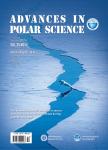Study of ionospheric disturbances during solar flare events using the SuperDARN Hokkaido radar
Study of ionospheric disturbances during solar flare events using the SuperDARN Hokkaido radar作者机构:Solar-Terrestrial Environment LaboratoryNagoya University
出 版 物:《Advances in Polar Science》 (极地科学进展(英文版))
年 卷 期:2013年第24卷第1期
页 面:12-18页
学科分类:070802[理学-空间物理学] 07[理学] 0708[理学-地球物理学]
基 金:supported by a Grant-in-Aid for Scientific Research,of the Ministry of Education,Culture,Sports,Science and Technology of Japan(Grant no.19340141) by Special Funds for Education and Research(Energy Transport Processes in Geospace)of the Ministry of Education,Culture,Sports,Science and Technology of Japan
主 题:solar flare SuperDARN Hokkaido radar Doppler shift D-region F-region GOES satellite
摘 要:It is well known that many types of ionospheric disturbances occur during solar flare events. The sudden increase in total electron content (SITEC) has been studied for several decades, but total electron content (TEC) data do not provide information on the altitudinal distribution of electron density changes. Previous studies used HF Doppler system data to investigate the contributions of the D-region and F-region ionospheric electron density changes by examining the HF radio wave frequency dependence on the Doppler shift values. In this study we examined the dependence of the elevation angle of the Doppler shift of ground scatter echoes using the SuperDARN Hokkaido radar. We analyzed solar flare events from Dec 2006 to Mar 2012. A sudden fade-out of echoes was observed in almost all the events we analyzed, which was the result of the radio absorption associated with a significant increase in electron density within the D-region ionosphere. In addition, we discovered positive Doppler shifts just before the sudden fade-out of echoes. The Doppler shift is negatively correlated with the elevation angle of received radar waves. It indicates that variation of electron density in the D-region ionosphere is dominant during solar flare events. This result is consistent with a previous study. We also compared the irradiation by X-ray and extreme ultra violet rays observed by the GOES-14 and GOES-15 satellites, which generated Doppler shifts. A positive Doppler shift is consistent with a change of X-ray




